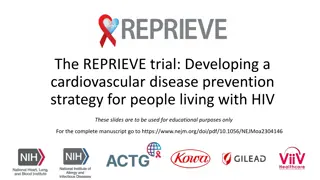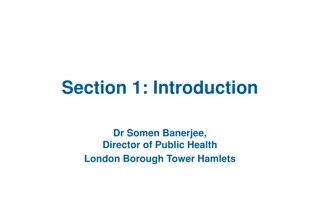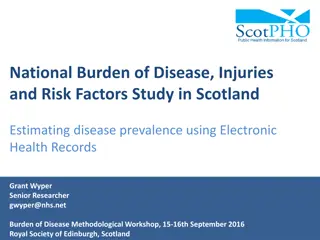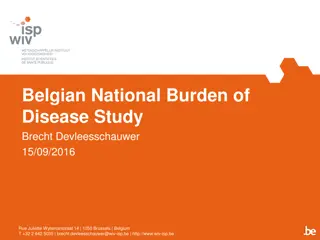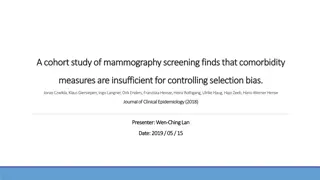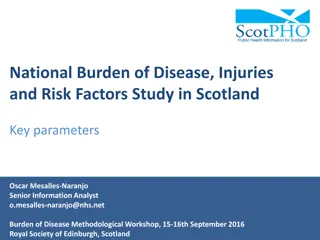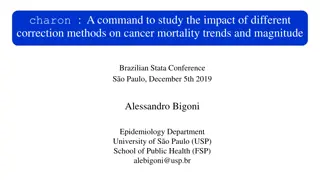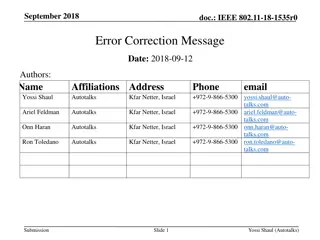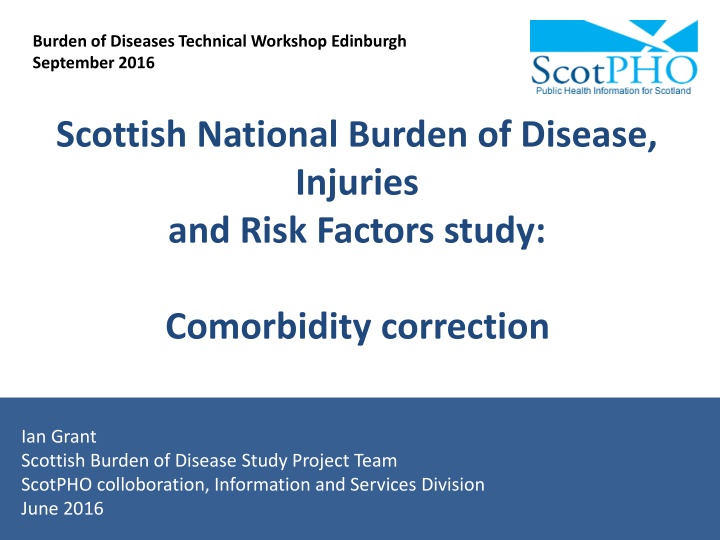
Scottish National Burden of Disease Study: Comorbidity Correction Workshop
This content discusses the implementation of comorbidity correction in the Scottish National Burden of Disease Study, focusing on correcting estimates of cause-specific YLDs and total YLD for biasing influences. The methodology involves adjusting disability weights based on comorbidity in a large micro-simulated population. The process includes modeling comorbidity, exploring independent vs. dependent comorbidity assumptions, and simulating comorbidity processes following the GBD methodological framework.
Download Presentation

Please find below an Image/Link to download the presentation.
The content on the website is provided AS IS for your information and personal use only. It may not be sold, licensed, or shared on other websites without obtaining consent from the author. If you encounter any issues during the download, it is possible that the publisher has removed the file from their server.
You are allowed to download the files provided on this website for personal or commercial use, subject to the condition that they are used lawfully. All files are the property of their respective owners.
The content on the website is provided AS IS for your information and personal use only. It may not be sold, licensed, or shared on other websites without obtaining consent from the author.
E N D
Presentation Transcript
Scottish Public Health Observatory logo Burden of Diseases Technical Workshop Edinburgh September 2016 Scottish National Burden of Disease, Injuries and Risk Factors study: Comorbidity correction Ian Grant Scottish Burden of Disease Study Project Team ScotPHO colloboration, Information and Services Division June 2016
Scottish Public Health Observatory logo Comorbidity in GBD GBD s focus on correcting the estimates of cause-specific YLDs and total YLD for the biasing influence of comorbidity, rather than on analysing patterns of comorbidity per se. Models comorbidity in a large micro-simulated population and uses this to adjust disability weights in the final estimates - wherever possible, inputs to the micro-simulation for each country, age, sex, year group will be at the level of health sequelae - places no upper limit on the number of comorbid conditions - micro-simulation process repeated (for each country-age-sex- year) 1000 times 2
Scottish Public Health Observatory logo Comorbidity in GBD Model comorbidity assuming independent multiplicative model (i.e. probability of experiencing a combination of sequelae is simply the product of the probabilities of experiencing each of the constituent sequelae). Independent vs. Dependent comorbidity (i.e. diseases may cluster because of common risk factors, or because one disease is itself a risk factor for other diseases. GBD tested independence assumption using US Medical Expenditure Panel Survey data which suggest that error in the magnitude of YLDs from using the independence assumption is minimal (Murray et al 2012) In New Zealand, reductions in overall YLD for dependent comorbidity beyond that required for adjustment due to independent comorbidity were small, although they did increase slightly with age (New Zealand Ministry of Health 2012) 3
Scottish Public Health Observatory logo SBoD comorbidity process Broadly following the GBD s methodological framework when adjusting our baseline (or default) estimates of YLDs for comorbidity bias i.e. Applying the multiplicative independence model : to Scottish estimates of individual disease and injury prevalences, to estimate prevalences for comorbidity, to the GBD disability weights / health losses for individual diseases and injuries, to estimate weights for comorbidity. 4
Scottish Public Health Observatory logo SBoD comorbidity simulation algorithm 1. Work with a synthetic population of size n, with the same age group and sex, and assume to be alive at the same calendar year. 2. For each individual i in a synthetic population set: (a) Assign him/her a number of co-morbidities Ci based on the probability distribution of the number of comorbidities (b) Repeat until the person has been assigned Ci different co-morbidities (i) Choose a disease sequela d based on a probability distribution RD (ii) Decide if the person has the disease d based on the probability of having such disease (point prevalence for the population subgroup) (iii) If the person has the disease: - Remove disease sequela from the list and update probability distribution RD Update number of comorbidities assigned to the person 5
Scottish Public Health Observatory logo SBOD Simulation algorithm (cont) (c) Once the person has been assigned Ci co-morbidities, work out the total co-morbidity adjusted disability weight for the simulant (d) And the disability weight attributable to each sequela for the simulant 4. Once all individuals have been done work out the YLD Rate for disease sequela k 6
Scottish Public Health Observatory logo SBoD Comorbidity process Not a full population simulation i.e. simulated population is 200 000 run the simulation ~1000 times. requires more than 1 year of computer power, that is 20 age groups x 1000 simulations x 40 min per simulation = 800 000 min = 555 days Or is it enough simulating 2000 people, 1000 times? Take into account probability distribution of the number of co- morbidities by age with a limit on number of comorbidities (by age group) 7
Number of chronic disorders by age group Source: Barnet et al, 2012 Epidemiology of multimorbidity and implications for health care, research, and medical education: a cross-sectional study
Scottish Public Health Observatory logo SBOD: impact of comorbidity correction comorbidity adjusted YLD % Disease YLD change Neck and low back pain 44,373 48,184 8 Other musculoskeletal disorders 37,734 41,104 8 Oral disorders 29,641 31,556 6 Inflammatory bowel disease 29,090 32,476 10 Sense organ diseases 20,831 22,447 7 Migraine 19,632 22,315 12 Depression 19,090 21,123 10 Diabetes mellitus 18,096 19,639 8 Ischemic heart disease 16,880 18,309 8 Anxiety disorders 16,041 17,536 9 9
Scottish Public Health Observatory logo SBOD supplementary analyses of comorbidity prevalences Consider whether and how best to exploit the potential of the Scottish evidence: Estimating the prevalence of comorbidities, to the depth of two or three co-present conditions. Assessing the degree to which the comorbidity prevalences observed in AHS and IHS conform to or depart from the multiplicative independence model. Making a broad assessment of the degree to which the overall adjustment of YLDs for comorbidity bias might be affected
Scottish Public Health Observatory logo Number of co-existing conditions Source: Measuring Long-Term Conditions in Scotland, Information Services Division, Edinburgh 2008 https://www.isdscotland.org/Health-Topics/Hospital-Care/Diagnoses/2008_08_14_LTC_full_report.pdf
Scottish Public Health Observatory logo Common combinations of conditions Source: Measuring Long-Term Conditions in Scotland, Information Services Division, Edinburgh 2008 https://www.isdscotland.org/Health-Topics/Hospital-Care/Diagnoses/2008_08_14_LTC_full_report.pdf
Scottish Public Health Observatory logo Discussion Comorbidity adjustment by means of a simulation presents multiple challenges, for instance: which co-morbidities and how many of them are assigned to a person; how the disability weights are combined. GBD methodology presents a solution to these questions, but is that the best methodology possible? How can data rich countries use their information to improve the comorbidity adjustment? Comorbidity


